Coronavirus (COVID-19) support study experiences of and compliance with self-isolation: main report
This research explores compliance with and experiences of the 10 day period of self-isolation undertaken by index cases, contact cases, and international travellers during the COVID-19 pandemic. The research took place between March and June 2021.
This document is part of a collection
8. Support during self-isolation
8.1 Background
It is recognised that there are a range of challenges and support needs as a result of being asked to self-isolate and that these can vary both for individuals and as the self-isolation period progresses. Key elements of the support offer at the time of undertaking the research included:
- Local Authority support: All Index and Contact Cases should be offered the option of their Local Authority contacting them solely for the purpose of identifying and providing support during self-isolation. All those who accept should then be offered an initial call to identify their support needs, appropriate support and the offer of up to two follow-up calls to check on them and their support needs. Local Authorities must provide the same basic offering around food, pharmacy, and financial support, however, there is scope for them to adapt their wider offer so this may not be consistent across Local Authorities.
- The National Assistance Helpline: Available to all, including those asked to self-isolate, this helpline links callers to mental health and wellbeing support as well as to their Local Authority where there is the potential to access a range of support, including with food, pharmacy deliveries, befriending and with their finances as above.
- Self-Isolation Support Grant: Recognising the potential financial impact of self-isolation, a Self-Isolation Support Grant of £500 was launched for those on low incomes, which can be applied for via an individual's Local Authority.
In addition, a scheme was launched whereby a letter is provided for employers to help with expectations around work that cannot be undertaken from home when an individual is asked to self-isolate.
One of the key areas of focus for the research was to understand more about the support needs of those asked to self-isolate, as well as knowledge and take up of the support on offer.
8.2 Formal support
8.2.1 Formal support offered to Index and Contact Case participants
Over half (56%) of Index and Contact Case participants indicated that, when asked to self-isolate, they were offered the option of their Local Authority contacting them. Smaller proportions recalled being offered online support (24%), the National Assistance Helpline number (21%) and/or support when visiting a test centre (4%). Yet three in ten (29%) Index and Contact Case participants did not recall being offered any of these formal support options when asked to self-isolate.
Index Case participants were more likely than Contact Cases to report having been offered the following formal support: the opportunity for their Local Authority to contact them (64% and 50% respectively); online support (28% compared with 20%) and/or being offered the National Assistance Helpline number (25% compared with 19%). [Figure 8.1, Table 8.1]
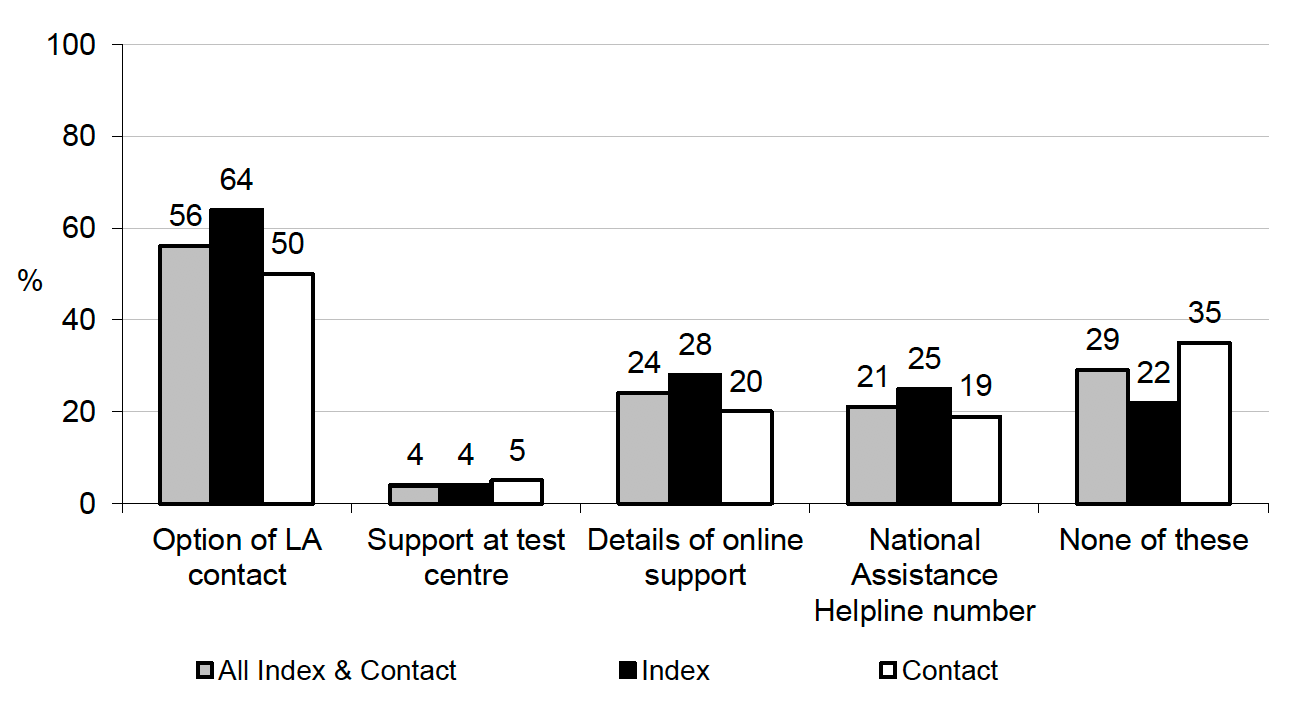
Participants aged 25-44 and 45-64 (58% and 59% respectively) were more likely than the youngest age group (45%) to mention having received the offer of LA contact. The proportion of those aged 65 or over who mentioned receiving the offer of Local Authority contact was not significantly different from that observed for other age groups. Other groups more likely to report being offered the opportunity for their Local Authority to contact them than others included: those living with others, including children, (54%-59%, compared with 47% of those living alone); those managing comfortably on their income during self-isolation (58%, compared with 51% who reported struggling on their income) and those who gave their ethnic origin as White (57%, compared with 49% who gave this as Non-White). [Table 8.1]
In the qualitative research, awareness of the support available during isolation varied from feeling fully informed of the support on offer, to not being aware that any support was available. Interviewees were not always able to say if the information or offers of support they received around self-isolation came from Test and Protect, the Local Authority or the NHS. However, a majority of the participants said that they were aware support was on offer from Local Authorities. This appeared to be due to being contacted and made aware of the Local Authority support by Test and Protect in the main, although others stated that they knew of this service via family members who worked at the Local Authority, as well as through schools. Other sources of information on the availability of Local Authority support included the Scottish Governmental daily briefings and through the media.
Those interviewees who reported an awareness of formal support said that either Test and Protect or a representative from the local council phoned to say help was available for shopping, medical prescriptions, dog walking and to offer support for mental health issues. This offer of support appeared to be appreciated, though the consensus was that assistance already on offer from family, friends and workplaces meant that no additional help was required (see Chapter 8.2.5 below).
It is important to note, that while most interviewees may have been aware that local authorities offered support, they did not always know what the support entailed. For some, this was because they didn't feel that they needed support so they didn't enquire further. For others, they confessed they may have been told but had not taken it in. It was argued that those being asked to self-isolate could benefit from more detailed information about what the local authority could offer in the way of assistance. There were interviewees who said it was an automatic response to say that they didn't need support but knowing more about what support was available may have made self-isolating easier. In particular, awareness of the eligibilty criteria of the Self-Isolation Support Grant appeared to be low amongst interviewees, with participants stating that they thought it was only for those on benefits or they had received mixed messages regarding who would qualify for the grant.
"The food shopping and medication, that's the only support I was offered, and obviously, to take the dog out…A lassie told me on the phone." (Index Case)
"Not from Test and Protect. (Name of) Council called me asking did I need any support with food shopping and things like that, but I just said no because I had family that were helping, but that was all." (Index Case)
"Yes, they phoned us up every time. Well, every time I've had any - they phoned us up every time I've been told to isolate; the local council has phoned us up and offered help… Asked if everything was all right." (Index Case)
A common sentiment expressed by participants was that even if they did not personally need support, they appreciated that the service existed for those in less fortunate circumstances. Therefore, the Scottish Government and local authorities continuing to offer a range of support to those who have been asked to self-isolate was deemed important by interview participants. Financial support, such as the Self-Isolation Support Grant, was mentioned as being important in recognition that people may not be able to work during isolation. Informing everyone asked to isolate of the types of support available, and how to access this support, was perceived to be an essential part of Test and Protect's work.
"If you were somebody who had been working throughout and cannot work from home, then obviously the grant is really good. I know that's already in place, but I think that's really important and that should be continued if we were ever to find ourselves in this situation again." (Index Case)
"I think it is important that people should be given assistance, I think that that is very important, people should be…encouraged to self-isolate." (Index Case)
8.2.2 Formal support accessed by Index and Contact Case participants
Uptake of Local Authority support was relatively low among Index and Contact Case survey participants, with one in seven (14%) of those offered the opportunity of contact from their Local Authority accepting the offer. Take up did not vary significantly between Index and Contact Cases. Acceptance was also higher among those with a limiting long-term illness (28%, compared with a 10% with a non-limiting illness and 12% with no long-term illness).
Variations in take up of the offer of LA contact were also evident by: area deprivation (21% of those living in the two most deprived SIMD quintiles accepted the offer, compared with 9% of those living elsewhere); household income (with acceptance of the offer declining in line with increased household income (23% among those with a household income of <=£16,900 to 8% among those with a household income of £52,201 or more); perceived financial hardship with 38% of those who reported struggling on their household income during isolation accepting the offer, compared with (7%) of those who felt they managed comfortably on their income.[62] [Table 8.2]
Five percent of Index and Contact Case participants indicated that they contacted the National Assistance Helpline directly. [Table 8.3]
8.2.3 Reasons Index and Contact Case participants accessed formal support
Most survey participants who accepted the offer of support from their Local Authority did so to receive financial and practical support. As Figure 8.2 shows around a third that accepted were interested in support with a Self-Isolation Support Grant application (34%), while a quarter mentioned financial support (bills, access to grants/benefits etc.) (25%), practical help with food deliveries and/or support with money to buy food (22%).[63] A further 15% wanted support with pharmacy deliveries. [Figure 8.2, Table 8.4]
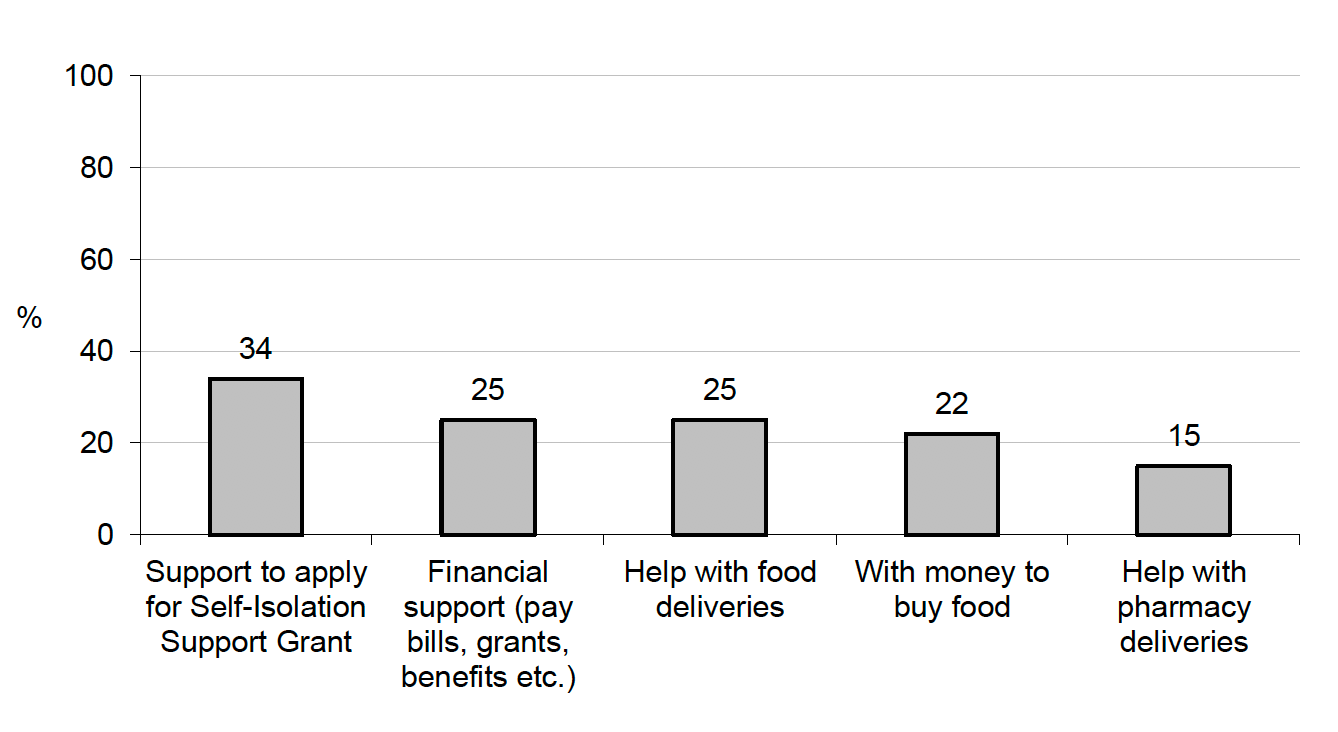
Just over seven in ten (72%) Index and Contact Case participants who agreed to the initial Local Authority contact also agreed to a follow-up call later in their self-isolation period. Common reasons for doing so included needing, or thinking they might need help: accessing food or other essential supplies (33%); help paying for food or bills (26%); because they thought they had to agree (20%) and/or in case their support needs had changed during self-isolation (19%). [Tables 8.5 and 8.6]
Common reasons for contacting the National Assistance Helpline were for additional information relating to self-isolation, COVID-19 symptoms, schooling etc. (34%). The proportions contacting the National Assistance Helpline for financial and/or practical reasons were lower than the proportions contacting their LA directly for these reasons. [Table 8.7]
8.2.4 How well Index and Contact Case participants' support needs were met
Index and Contact Case survey participants who accepted contact from their Local Authority, contacted their Local Authority directly and/or contacted the National Assistance helpline were asked if their support needs had been met. Most participants who accepted or sought help indicated that their support needs had been met (76%). Three-quarters of those who accepted contact from their Local Authority had their needs met, similar to the proportion who contacted their LA directly. Four in five (83%) of those who called the National Assistance Helpline for support reported that their support needs were met. [Figure 8.3, Table 8.8][65]
| Response | Total | Accepted offer of Local Authority contact | Contacted Local Authority directly | Contacted National Assistance Helpline |
|---|---|---|---|---|
| Yes (either) | 76% | 75% | 75% | 83% |
| No | 24% | 25% | 25% | 17% |
| Base | 340 | 149 | 205 | 99 |
In the qualitative research, those who had received the Self-Isolation Support Grant, or financial help towards utility bills, were appreciative and said that this had helped them. In addition, those who were contacted by telephone with offers of help thought that this was a worthwhile service, even if they did not need any assistance themselves, they thought others could benefit from the offer of support.
"[Self-Isolation Support Grant] did cover up the income that was lost for that kind of job, so I would say to that extent it was helpful…My missus did bridge the gap in terms of her work hours. It came down to the same, it just bridged the difference. It was helpful in that way, but apart from that there was no additional kind of positive in relation to it." (Household Contact Case)
"For the self-isolating side and the information you can get, yeah, that's great – but as I said, I didn't take anything. There are people worse off than me that need volunteers so I didn't make use of anything else." (Contact Case)
Both positive and negative examples of local authority support were cited in the qualitative research. Participants reported receiving the Self-Isolation Support Grant, as well as delivery of food parcels, shopping and financial support with electricity bills. This support was appreciated by the participants.
"… but financially I got a support grant from the local council because I couldn't…obviously my job I need to go into the house and do it so I couldn't work so I got a £500 Isolation Support Grant which helped…I knew I would be unable to go to work and I'd be missing out on money and yeah I could have done with it basically because it was 10 days of me not working. I think I normally work about 20 hours a week so it was going to be quite a loss of income." (Index Case)
"They told me to fill in an online application. I did. I filled in the application and I gave them evidence and they got back to me two days later, saying that my income was too high, but then I explained to them that my income isn't that high this month. I'm getting paid in nine days…and due to me being off for that week, I really am going to struggle to pay my rent, struggle to do things like that. There was a lot of bills to pay, and that was going to be put towards my rent and now I'm in arrears...I've applied for support…and I've got to wait for the outcome." (Index Case)
"First time [I self isolated], yes, [they helped with food delivery]...They just phoned up and asked if I was all right, if I had plenty of food, and did I have any problems with money or anything? If I did, they said that if I had, I had the number and I just had to contact them and they would help us." (Index Case)
The interviewees who gave mixed or negative feedback in relation to Local Authority support tended to have quite specific issues that they had complaints about. Two participants spoke of applying for the Self-Isolation Support Grant, one unsuccessfully and the other still waiting on the results of an appeal. Participants thought the eligibility criteria for the grant were too narrow and perceived it as more for those on benefits or without any income. Those on lower incomes felt they had been excluded from applying despite their financial difficulties. An individual phoned up for help with a prescription (from a dentist), but was strongly critical of the service when told that no help was possible. A dog owner did think of using a volunteer to walk the dog, but again no-one was available. Finally, participants wondered if a more specific, targeted phone call may be most useful rather than an open-ended call asking if help was needed, for example, if help may be needed with the payment of utility bills.
"That was easy as I say. I done it…but as I say I tried it and because I never heard anything back I thought well I'm not entitled to it because I was still working. Whereas everything is geared for folk who are'nae working, they're getting all the help. The folk who are on minimum wage doing what they've to do, you work through all the pandemic, we're not entitled to nothin'." (Household Contact Case)
"I phoned them regarding the prescription there was no support. They said we are sorry we cannot help you…By that time I'd lost confidence in them and I just said I'm not going to bother with them anymore…The one and only service that I used was very poor quality." (Index Case)
"I thought it was about right apart from it wasn't that easy to find the information about that grant but apart from that I thought everything else was all good." (Index Case)
Some interview participants argued that additional support was needed. For example, there were interviewees who were not eligible for support or said that the support they required was not available in their area. To address these issues and help more people to isolate fully in the future, participants made a number of suggestions. These included:
- Test and Protect and/or Local Authority to call everyone (including International Travellers) isolating at the start, middle and end of the 10 days self-isolation period to offer support, as people's circumstances may change
- Widening the eligibility of the Isolation Support Grant, for example, to everyone who has lost income as a result of self-isolation
- Further promotion and communication of the full range of support on offer for those who have to isolate and any eligibility criteria
- Provide everyone who is isolating with a written list of sources of support and relevant contact details. Ensure a range of formats are available
- Make it easy for people to find information about isolation support on the Test and Protect website (e.g. add an index and better search options to the Test and Protect website so key messages are easy to find, streamline text communication so it easier to digest, provide a downloadable PDF option to the website)
- Provide resources to help people look after themselves physically and mentally during isolation. This could be in the form of printed materials or links to online support
- Provide additional support for those with caring responsibilities (e.g. so they do not break isolation guidelines to provide this support to others)
- Provide access to local volunteers (e.g. via local council) who can help those isolating
- Access to online interactive activities for children to enable parents with COVID-19 to rest
- Local Authority to provide support to pay bills while self-isolating (for those who do not do internet or phone banking).
It is important to note that some of this support should already be available to those self-isolating. For example, Local Authorities can help with paying bills through pre-pay meters, crisis grants or by advising how to talk to energy companies about bill payment over the isolation period. Furthermore, Local Authorities can call people up to three times during the isolation period, but only if people consent to their details being passed on to their Local Authority.
8.2.5 Reasons Index and Contact Case participants did not accept formal support
The majority (83%) of Index and Contact survey participants that were offered the option of contact from their Local Authority declined the offer, with most doing so because they did not need any additional support (84%). Fourteen percent indicated that all the information they needed was available online, while 8% declined the offer of Local Authority contact as they were not sure what support was available and whether they needed it. Reasons for declining the offer of Local Authority support were generally similar among Index and Contact Case participants). [Table 8.9]
While there were no significant variations by sex or age some groups were more likely than others to decline support because they felt all the information was available online: non-carers (15% declined for this reason compared with 9% among carers) and those living in less deprived areas (13% compared with 19% among those living in the two most deprived SIMD quintiles (19%). [Table 8.9]
On the whole, the qualitative interviewees thought that this formal support was not needed. Family, friends and neighbours could help with shopping and prescriptions, and online shopping deliveries were often already in place. However, a few interviewees did apply for the Self-Isolation Support Grant unsuccessfully, or did not apply as they assumed they would not be eligible. There was also a view expressed that interviewees did not want to take grants or food away from those who were less fortunate and perceived to be in major need. Other issues, such as the provision of dog walking, were not taken up as interviewees did not always think it safe or sensible to hand a dog over to someone else, as there was a risk of transmitting the virus.
"The dog one, no, because I just thought, somebody has got to stand at my front door, I've got to hand over the dog and things like that. I just thought that was pathetic to be honest. The food shopping and medication, I get my medication monthly, so that was not a bother. The food shopping I'd done online…I'm terrible, I always make sure that there's plenty in. The cupboards are always full and things like that. I would be taking off of somebody that needs it when we don't need it. Give it to somebody that's maybe needing support. We're fortunate that we didn't need the support." (Index Case)
"No. That was the thing that was kind of like 'well, that's fine' but we wouldn't…morally we wouldn't to take anything that would take away the opportunity for someone last fortunate than us to…I know that sounds very gallant but I don't mean it that way. It would have been wrong for us to have said 'oh yes, please help us' when we were managing quite fine without it you know?" (Household Contact Case)
8.2.6 Self-Isolation Support Grant (SISG)
The Self-Isolation Support Grant (SISG) is a form of financial support available for those self-isolating as an Index or Contact Case who are on a low income. At 8%, the proportion of Index and Contact Case participants indicating that they had applied for a SISG was low, with no variation by case type.
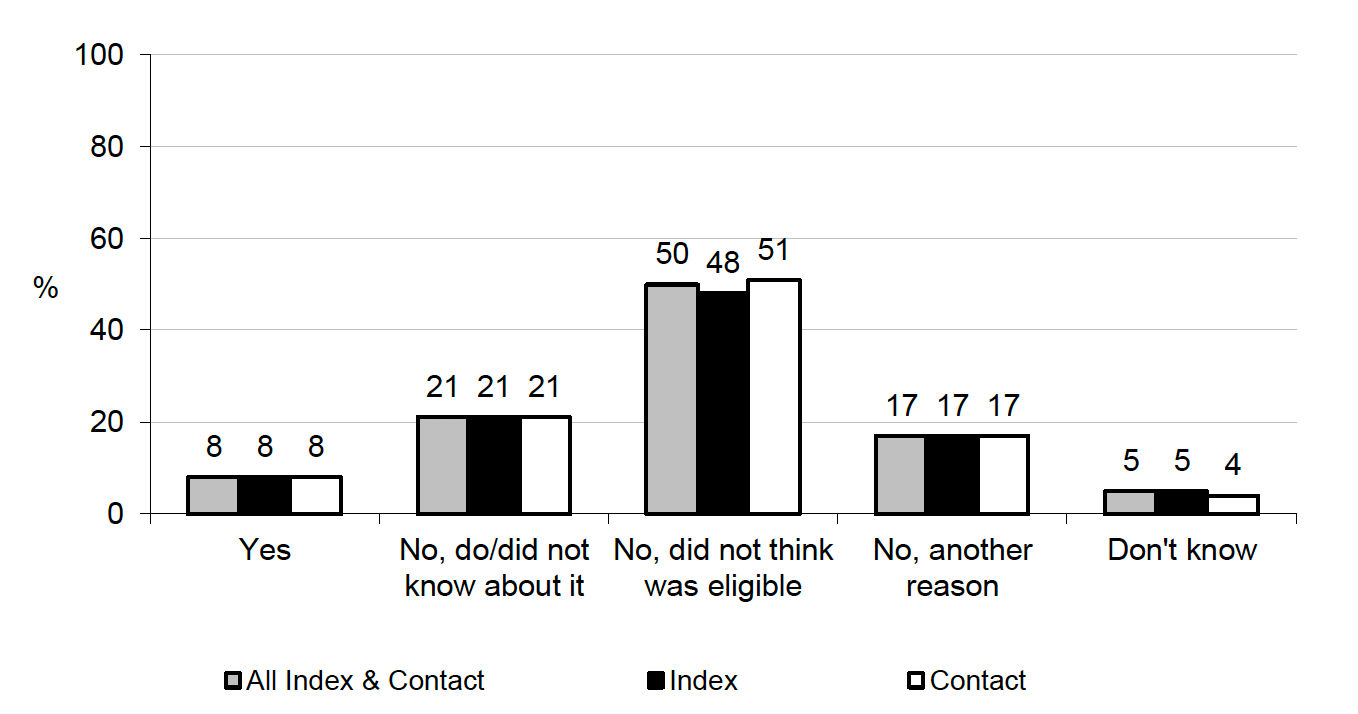
Applications for the SISG were higher among those living in Scotland's two most deprived SIMD quintiles (13%) than among those living elsewhere in Scotland (5%). Applications also varied by household income, with 17% of those with a household income of <=£16,900 and 13% of those with a household income of £16,901-£30,700 having submitted an application compared with 2-5% of those with a household income of £30,701-£52,200 or more. [Figures 8.4 & 8.5, Table 8.10]
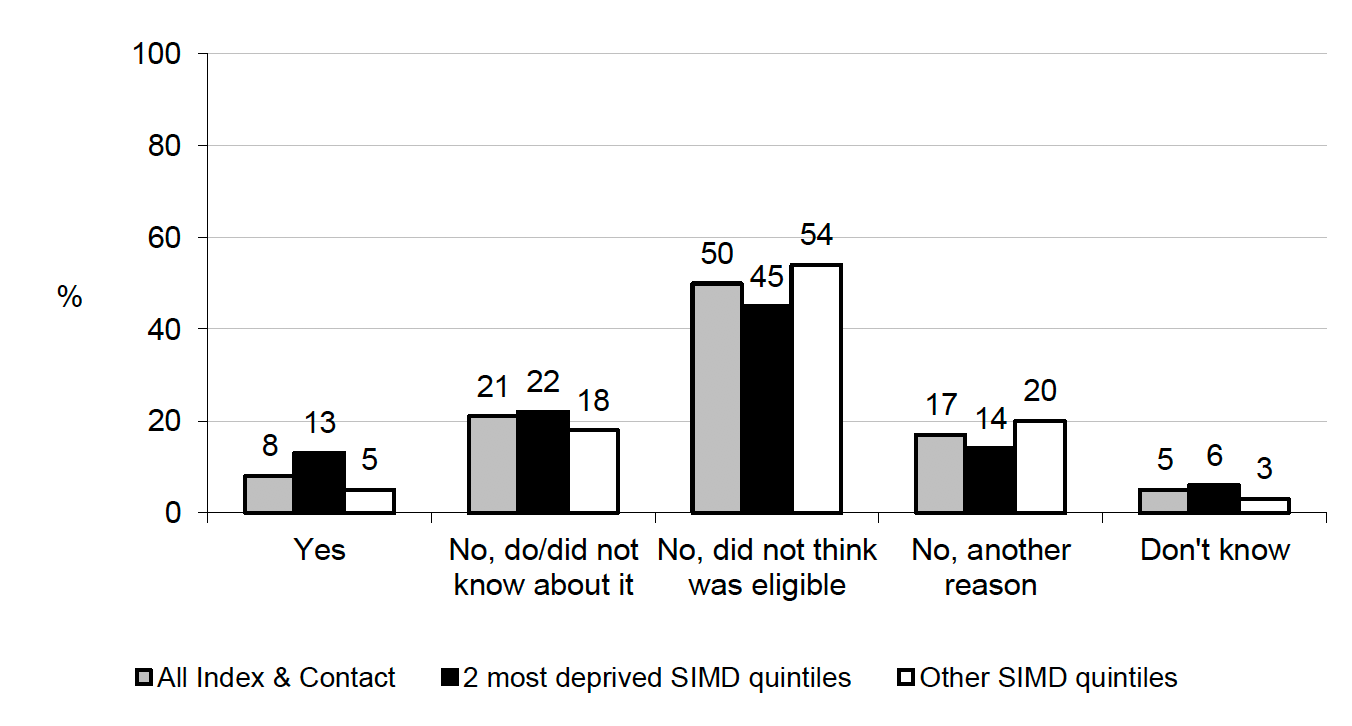
At the time of fieldwork, around a third of Index and Contact Cases who had applied for the grant had been successful in their application (37%), while around a quarter (27%) had been told that their application was unsuccessful and for a similar proportion (29%) a decision was pending. [Table 8.11]
Most of those who did not apply for the SISG said the reason they did not was because they did not think they were eligible (50%) and/or they did not know about it (21%). The data is indicative that those on lower household incomes were more likely than those with higher incomes to cite lack of knowledge about the grant as a reason for not applying. Whereas the opposite was true when it came to eligibility, that is, those on higher incomes were most likely to state that they did not apply due to perceptions of ineligibility (60% of those with a household income of £52,201 or more).[66] [Table 8.10]
8.3 Formal support for International Travellers
Only small proportions of International Traveller participants directly sought assistance from either their Local Authority (7%) and/or via the National Assistance Helpline (3%), with no significant variations by whether they were on a managed isolation package or self-isolating and testing at home. [Table 8.12]
Among those International Travellers who sought formal support[67], around three in ten (28%) did so in order to access additional information (on self-isolation rules, COVID-19 symptoms, schooling etc.), while around one in ten were seeking support with food deliveries (12%) and/or financial support to pay bills, access to grants/benefits etc. (9%). [Table 8.13]
Most (72%) International Travellers who sought formal support either from their Local Authority directly and/or via the National Assistance Helpline agreed that their support needs were met. [Table 8.14]
The International Travellers who took part in a qualitative interview reported very little support being offered or received in the qualitative research. However, participants acknowledged that they may not have been liable for Local Authority support in any case. International Travellers said they would have benefited from more support in the form of clear and easy to find information on self-isolation requirements returning to Scotland, either directly or via the UK as they reported that clear information was difficult to find online and they struggled to get hold of someone by phone to provide this information. Three of the International Travellers gave mixed or negative feedback on information or support they had received as they perceived that:
- Guidance on the Scottish Government website was said to be lacking or very difficult to find
- Initial phone calls from Test and Protect had been undermined due to the caller providing the wrong dates
- The government, local council and air company were all strongly criticised by a participant for not responding to direct queries when he aimed to return from abroad.
"As I said, I didn't think it was very good, the fact that initially they had the wrong dates and things was quite poor. I thought that finding the advice yourself on the government website was just quite difficult. It's lots of little bits here and there; you have to click on a link to find the thing you want. There's not just a big document that you, 'Here's a book' or, 'Here's a presentation or a PowerPoint thing' or a PDF that you can just read all the guidance right the way through from start to finish. You have to follow links and you can miss links easily and the fact that they're quite difficult to - the generic or the information that most people need was very easy to find, but just the little tiny details I found quite difficult to find…As I say, when I got the phone calls, because the information was wrong to start with and, being honest, I didn't really pay much attention to them; I was just answering 'yes, no and yes okay' as they went because by then you'd lost confidence that they actually knew what they were talking about." (International Traveller)
"I think the only thing at the time was the worry of what do I do when I'm coming back to Scotland and that was cleared up by the time I travelled which is the whole thing of if I enter via England where do I quarantine and that was up on the site. It's actually a lot more clearer on the Scottish Government guidelines rather than if you go and look at England, it's definitely a lot more clear." (International Traveller)
8.4 Informal support among Index and Contact Case participants
The majority (81%) of Index and Contact Case survey participants responded that they had support from friends, family or neighbours outside of their household if they needed it, with no significant difference between Index and Contact Case participants. [Figure 8.6, Table 8.15]
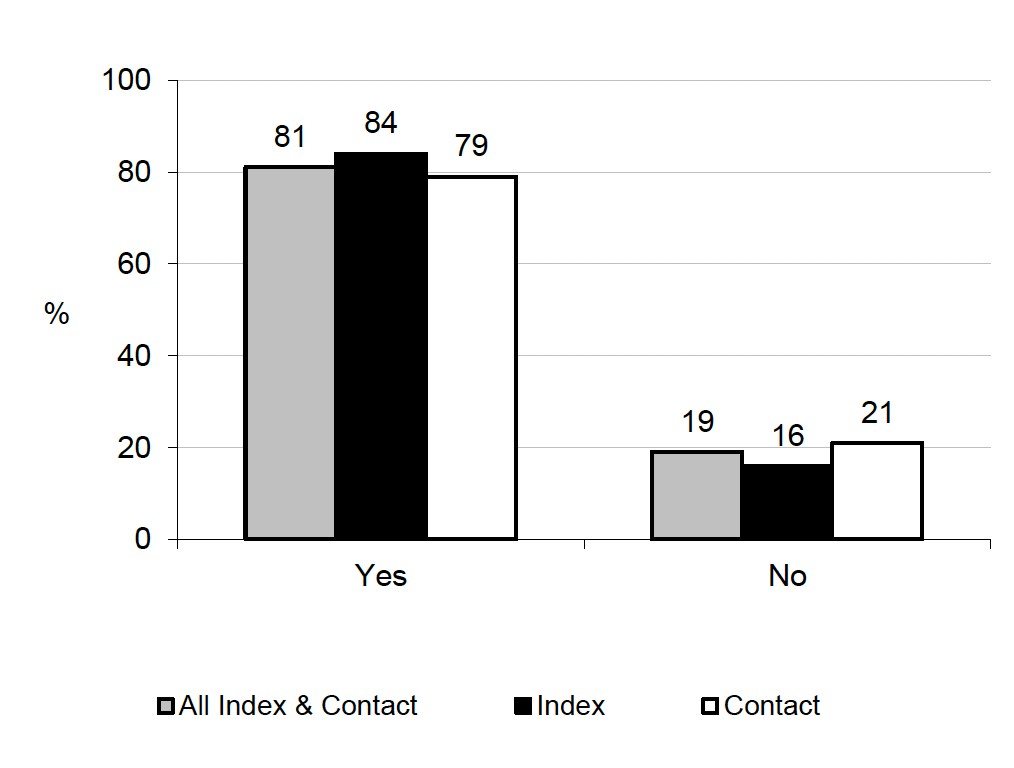
Women were more likely than men to indicate that they had the support of friends, family or neighbours (84% and 76% respectively). Other groups more likely to report having informal support while self-isolating were: those whose ethnicity could be classified as White (83%, compared with 65% of those who chose an ethnicity of Non-White ethnic origin); and those with no long-standing illness or a non-limiting illness (83%), compared with those with a limiting illness (75%). [Table 8.15]
Interestingly, there was an association between availability of informal support (friends, family or neighbours) and accessing Local Authority support. Those who took up the offer of contact from their Local Authority were more likely to respond that they did not have informal support (28% compared with 14% of those who did not take up this offer). Similarly, 27% of those who contacted their Local Authority directly had no informal support compared with 18% of those who did not contact their Local Authority directly for support. [Figure 8.7, Table 8.15]
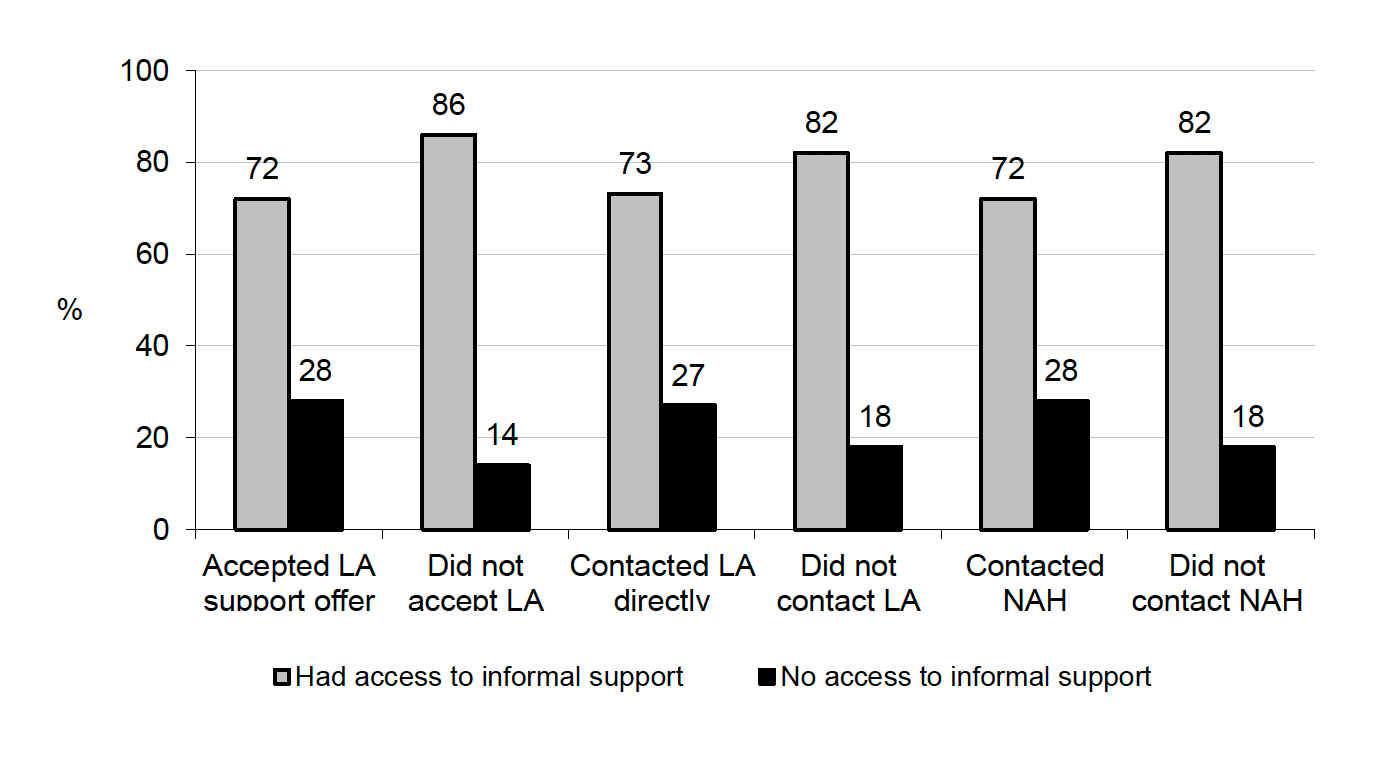
In the qualitative interviews, participants cited a number of additional support sources that had helped them during self-isolation. The assistance given by family, friends and neighbours, for example, in relation to more functional aspects such as shopping, taking children to and from school and dog walking was reported, as well as in terms of providing emotional support. Participants also used online sources of help for food and pharmaceutical deliveries, information on self-isolation and COVID-19 testing (though they were not always able to differentiate between UK and Scottish Government websites), and maintaining contact with family and friends via FaceTime and similar applications.
Workplaces were also praised for the support they provided during the self-isolation period. These organisations offered help with shopping and deliveries, online childcare, mental health support via resources such as 'Mindapples' as well as phone calls and emails to ask how individuals and family members were coping with self-isolation. Where people had to self isolate because a contact at work had tested positive, employers informed people to self isolate and get a test, even before T&P were in contact. Local pharmacies also helped individuals by delivering prescriptions when it became clear that there was no one available to pick up the orders.
Other ways in which online and social media platforms helped was via online forums and community groups, as well as the ability to keep in contact with friends and family. For example, an interviewee posted about his plight on Facebook, and local takeaway outlets contacted him and delivered meals as a consequence. A local community 'lend a hand' group also helped an individual and family members who were self-isolating.
"I did need to get medication at one point, and I used Amazon to deliver it...I do actually have a friend who lives two doors up and she offered. She was like, 'If you need anything, then just let us know and we'll drop it off,' so I could have asked them. I could wait 24 hours for some more paracetamols, or just got it off Amazon, so that's fine." (Index Case)
"We've got a range of resources through my work, so things like 'Mindapples' is one of them, a bunch of other bits and pieces we've got to support mental and physical health. There's a lot of things that I was doing through that. Just things like meditation and exercises and things that they have set up to support. We've actually got a gym that put up YouTube videos that we can follow and do exercise and so forth. I think having that sort of private bank of things was quite good…" (Contact Case)
8.5 Informal support among International Travellers
Availability of informal support was lower among International Traveller participants than among Index and Contact Case participants, with 61% reporting having the support of family, friends or neighbours outside their household during self-isolation (compared with 81% among Index and Contact Case participants combined). Those self-isolating at home were significantly more likely than those in managed isolation to report having informal support available to them while self-isolating (65% and 41% respectively). [Figure 8.8, Table 8.16]
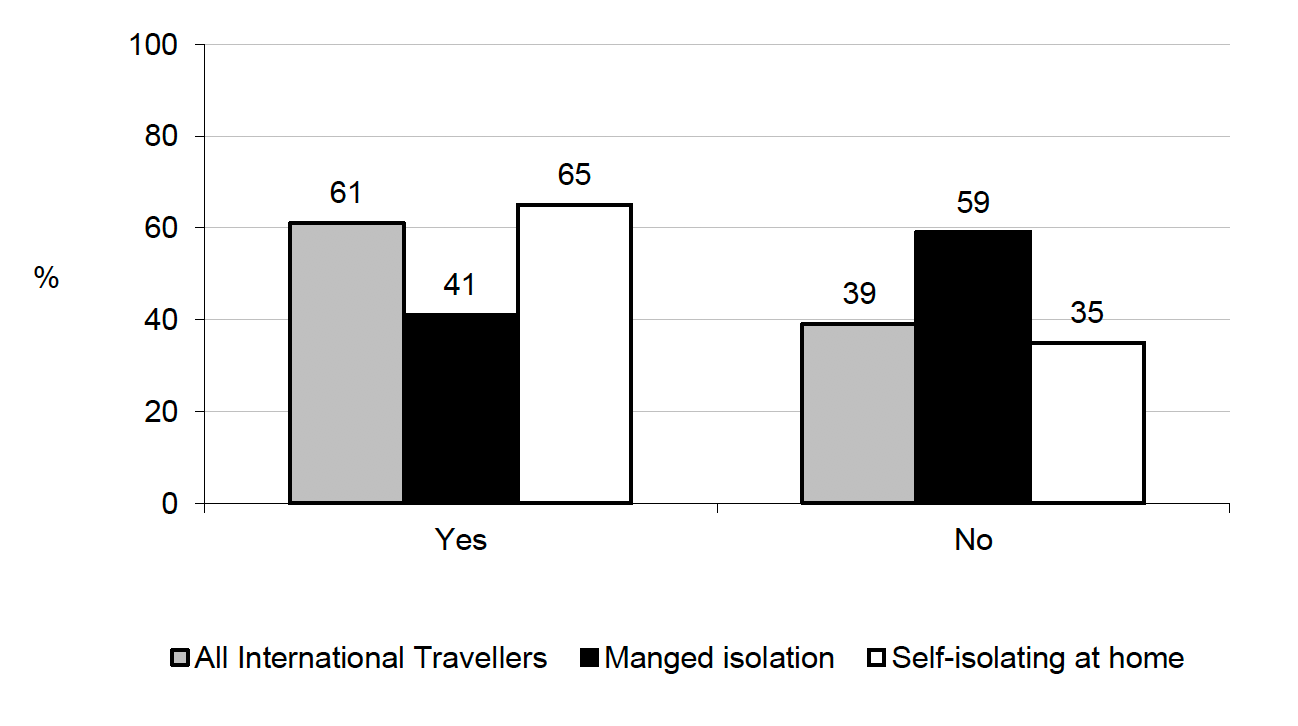
As was the case among Index and Contact Case participants, female International Traveller participants were more likely than males to report having the support of friends, family and/or neighbours (67% and 58%). In addition, those reporting that they managed comfortably on their household income while self-isolating (66%) were more likely than others to report having informal support available to them.
8.6 Communication with Test and Protect: participant preferences
The majority of participants were contacted by Test and Protect in several different ways. Many reported receiving a text message followed by a phone call, and less commonly a few reported receiving an email. No participants reported receiving a notification on the app. Interview participants were asked what kinds of communications they would find most helpful in aiding them to understand what isolation support was available. A number of forms of communication, and combinations, were highlighted. These include:
- A phone call only
- A phone call combined with a follow-up email, letter or text
- Email, letter, text with the option to follow up with a phone call
- Advertisements
- Communication via the Test and Protect App and website.
Participants who stated that a phone call helped them to understand what isolation support was available did so for a number of reasons. A phone call gave participants a chance to ask questions and to receive an immediate response. In addition, it was felt that a phone call ensured people engaged with the information being shared, whereas an email, text or letter could be ignored or missed. Furthermore, the personal contact of a phone call was deemed important for those self-isolating, particularly those who lived alone. An International Traveller said they would have liked there to be an option of a video call because English was not their first language and they found that being able to see someone's face helped them to understand what was being said.
"Well for me the one-to-one human voice because the isolation is so acute, the one thing you lost is human contact, to actually have a human being speaking to you is very, very important…it actually made an impact to speak to somebody because it breaks that isolation." (International Traveller)
"I think a telephone call definitely. I know that, again, maybe not just for me but for people like my parents, so for the older age bracket maybe, but a telephone call I think is better than an email. You can say, 'Oh, I've got a few emails, I'll read them later or I'll read them at my leisure or I might not even read them at all.' I think a telephone call is good because when you're speaking to a person you've got to respond. Well, I feel you're more likely to respond. I suppose you could put the phone down, but you're more likely to respond and engage in a conversation and do have that conversation with a human being as opposed to a machine or an automated message that you're getting." (Contact Case)
Participants who preferred to receive information about self-isolation via an email, letter or text, felt this way as they said it was something they could refer back to whereas they may not be able to remember everything that was said on a phone call, particularly if they were experiencing COVID-19 symptoms or experiencing shock of being asked to self-isolate. Participants had different preferences for emails, letters or texts. Letters were deemed most suitable for those who do not use technology and texts were favoured by some because they thought it was more accessible than emails, which obviously require an email address and access to the internet. Overall, participants thought people should be able to choose the format of the written information.
"For me, I quite prefer [information] in either an email or a text format, just for the fact that I can refer back to it. That obviously helped me when it came to understanding, do I need to self-isolate for the whole ten days or can I go out? I went to that text and I had a look online, so that certainly helped. Probably something to be made to the online site to make it a bit more clear as well, but certainly for me the email and text was the way I preferred." (Contact Case)
A combination of a phone call and written information was deemed the best of both worlds, with some favouring written information to follow the phone call while others would prefer to receive written information with the choice to follow up by phone if they had any questions.
There were interview participants who found out about isolation support through people they knew rather that Test and Protect. Therefore, it was suggested that information about isolation support should also be communicated via the Test and Protect website, leaflets posted to people's homes and in public places (such as health centres) and advertised on TV, radio, bus stops, Facebook and other social media.
"Maybe more on TV regarding self-isolation as well and no' basically geared to folk who are on benefits as in in general what everybody can get and what everybody can do to help that that time…Or even on the radio…As I say an email no. Not everybody does have the internet." (Household Contact Case)
Contact
Email: socialresearch@gov.scot
There is a problem
Thanks for your feedback